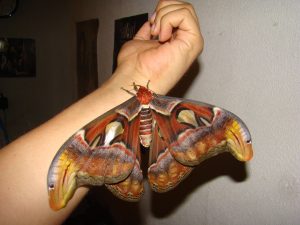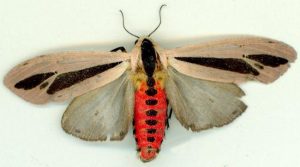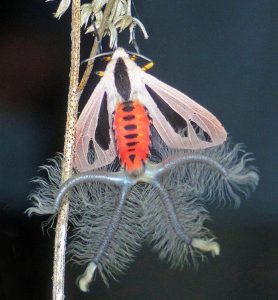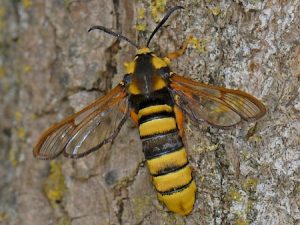Podcast: Play in new window | Download (Duration: 8:15 — 9.0MB)
Thanks to Joel and an anonymous listener for their suggestions this week!
Further reading:
Dieback and recovery in poplar and attack by hornet clearwing moth
The enormous and beautiful Atlas moth:

A male hairy tentacle moth without and with coremata extended [photos from this site]:


The hornet moth looks like a hornet but can’t sting:

Show transcript:
Welcome to Strange Animals Podcast. I’m your host, Kate Shaw.
Welcome to September, where we’re mere weeks away from Monster Month! Invertebrate August is over for another year, but what’s this? An episode about moths?! Hurrah for one extra invertebrate episode, because they don’t get enough attention on this podcast! Thanks to Joel and an anonymous listener for their suggestions.
First, a listener who wants to remain anonymous suggested that we talk about moths in general, and the Atlas moth in particular. I like the Atlas moth because you can catch it in Animal Crossing. It’s also beautiful and one of the largest moths in the entire world. Its wingspan can be well over 10 inches across, or about 27 cm, which is bigger than a lot of bird wingspans.
The Atlas moth’s wings are mostly cinnamon brown with darker and lighter spots. The upper wings have a curved sort of hook at the top that’s lighter in color and has an eyespot. It looks remarkably like a snake head, and in fact if a predator approaches, the moth will move its wings so that it looks like a snake is rearing its head back to strike.
Despite having such huge wings, atlas moths don’t fly very well. That’s okay because they only need to be able to fly for a few days, which they mostly do at night. They’re only looking for a mate, not food, because they don’t even have fully formed mouthparts. They don’t eat as adults. Like many moths, they mate, lay eggs, and die.
A few weeks later, the eggs hatch and the baby caterpillars emerge. The caterpillar is pale green with little spikes all over, and it eats plants until it grows to around 4 and a half inches long, or about 11 and a half cm. At that point it spins a cocoon attached to a twig, hidden from potential predators by dead leaves that the caterpillar incorporates into the cocoon’s outside.
The Atlas moth lives in forests in southern Asia, including China, India, Indonesia, and Malaysia, with a subspecies native to Japan. Its cocoons are sometimes collected to use for silk. The silk isn’t as high a quality as the domesticated silk moth’s, but it’s very strong and since the cocoons are so big, they produce lots of silk. Sometimes people will collect a cocoon after the moth has emerged and use it as a little purse.
Next, Joel suggested two interesting moths. The first is often called the hairy tentacle moth, which sounds absolutely horrifying. Its scientific name is Creatonotos gangis, and it lives in parts of Australia and southeast Asia.
The hairy tentacle moth is also called the Australian horror moth and other names that inspire fear and disgust. But why? The moth is really pretty. Its wings are pale brown and white with dark gray stripes in the middle, and it has a black spot on its head. The abdomen is usually red with black spots in a row. The wingspan is about 40 mm.
The issue comes with the way the male attracts a female. Inside his abdomen the male has four coremata, which are glands that emit pheromones. Pheromones are chemicals that other moths can detect, much like smells. When a male is ready to advertise for a mate, he perches on the edge of a leaf or somewhere similar and inflates the coremata so that they unfurl from inside the abdomen, like blowing up a balloon. Sometimes he only extends two of the coremata, sometimes all of them. Either way, the coremata are surprisingly large, sometimes longer than the entire abdomen. They’re dark gray with feathery hairs and they do actually look like hairy tentacles. They’re sometimes called hair pencils, but the term coremata is actually Greek for feather dusters.
If you don’t know what they are, the coremata really do look weird and unpleasant. But the moth is just doing his best to get his pheromones picked up on the breeze so a female will find him. The pheromone also repels other males.
The hairy tentacle moth can only develop his coremata and the pheromones he needs if he eats enough of plants that contain pyrrolizidine alkaloids. These are intensely bitter compounds that are also toxic to many animals. When he’s a caterpillar, the male eats plants that contain these alkaloids and retains them in his body, chemically modifying them later into pheromones, but if he doesn’t eat enough of them, he’s not able to grow coremata either.
Finally, Joel also suggested the hornet moth, which lives in Europe and the Middle East. It’s a moth, but it genuinely looks exactly like a yellow and black striped hornet. It even has clear wings like a hornet or wasp and flies like one too, and it’s about the size of a hornet. Even though it’s harmless, it looks like it would give you a bad sting, which protects it from potential predators who know better than to mess with a hornet. It’s a great example of what’s called Batesian mimicry, but it has one big drawback. The moth lives in some areas where there aren’t any hornets, and in those areas birds and other animals soon learn that those brightly striped insects are yummy and easy to catch.
The female hornet moth lays her eggs in the plants around the base of a tree or on its bark, especially the poplar tree. When the eggs hatch, the larvae spend the next two or three years in and around the tree, mostly around its roots. It eats the wood of the roots, and when it’s ready to pupate it burrows into the tree trunk and spins its cocoon in the burrow. The problem is that it needs the cocoon to be protected inside the tree, not near the entrance of the burrow, but when it emerges from the cocoon it needs to be near the entrance or its newly metamorphosed body will be too large for it to crawl out. To solve the problem, when it’s getting close to emerging, the moth will wriggle around in its cocoon so energetically that it manages to push the pupa up the burrow to the entrance. You can imitate this action by zipping yourself into a sleeping bag and trying to crawl across a room.
For a long time people thought the hornet moth was damaging poplar trees by this behavior, causing them to die. It turns out that the moths aren’t hurting the trees, they’re just more noticeable when poplars are already injured by drought.
There’s also an American hornet moth that lives in some parts of the Midwest and western areas of North America. It’s closely related to the hornet moth of Europe and adults look an awful lot like hornets, but they don’t sting. So the next time you’re about to run from a hornet, take a moment to determine if the hornet is actually a harmless moth. Or at least don’t run, just walk away quickly and safely. Just in case.
You can find Strange Animals Podcast at strangeanimalspodcast.blubrry.net. That’s blueberry without any E’s. If you have questions, comments, or suggestions for future episodes, email us at strangeanimalspodcast@gmail.com. We also have a Patreon at patreon.com/strangeanimalspodcast if you’d like to support us for as little as one dollar a month and get monthly bonus episodes.
Thanks for listening!